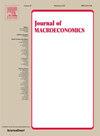What caused the post-pandemic inflation in France? An analysis using the Bernanke–Blanchard model
IF 1.5
3区 经济学
Q3 ECONOMICS
引用次数: 0
Abstract
We analyse post-pandemic inflation in France using the Bernanke–Blanchard semi-structural model of wage and price inflation. This model builds on a wage Phillips curve, a mark-up price-setting equation and adaptive equations for short- and long-run inflation expectations. Wage and price inflation as well as inflation expectations are modelled as functions of a labour market slack indicator (the vacancies-to-unemployed ratio), energy and food price shocks, a measure of supply-chain disruptions (“shortages”) and other exogenous factors (trend productivity, Covid lockdowns/re-openings). We estimate the model from the 1990s to 2023Q2 and derive impulse response functions and historical decomposition of endogenous variables during the pandemic era. As BB for the US, we find that the main driver of the post-pandemic inflation was the energy price shocks at first, followed by the food price shocks. Labour market conditions initially played a minor role in inflation, although the substantial increase in wage inflation observed between 2021Q4 and 2023Q2 can be attributed predominantly to the tightening of the labour market.
是什么导致了大流行后法国的通货膨胀?使用贝南克-布兰查德模型的分析
我们使用贝南克-布兰查德工资和价格通胀的半结构模型分析了大流行后法国的通胀。该模型建立在工资菲利普斯曲线、加价设定方程以及短期和长期通胀预期自适应方程的基础上。工资和价格通胀以及通胀预期被建模为劳动力市场闲置指标(空缺与失业比率)、能源和食品价格冲击、供应链中断(“短缺”)的衡量标准以及其他外生因素(趋势生产率、新冠肺炎疫情封锁/重新开放)的函数。我们估计了从20世纪90年代到2023Q2的模型,并推导了大流行时期内生变量的脉冲响应函数和历史分解。作为美国的BB级,我们发现,疫情后通胀的主要驱动因素首先是能源价格冲击,其次是食品价格冲击。劳动力市场状况最初对通胀的影响较小,尽管在2021Q4和2023Q2之间观察到的工资通胀大幅增长主要归因于劳动力市场的紧缩。
本文章由计算机程序翻译,如有差异,请以英文原文为准。
求助全文
约1分钟内获得全文
求助全文
来源期刊

Journal of Macroeconomics
ECONOMICS-
CiteScore
2.50
自引率
7.10%
发文量
53
审稿时长
76 days
期刊介绍:
Since its inception in 1979, the Journal of Macroeconomics has published theoretical and empirical articles that span the entire range of macroeconomics and monetary economics. More specifically, the editors encourage the submission of high quality papers that are concerned with the theoretical or empirical aspects of the following broadly defined topics: economic growth, economic fluctuations, the effects of monetary and fiscal policy, the political aspects of macroeconomics, exchange rate determination and other elements of open economy macroeconomics, the macroeconomics of income inequality, and macroeconomic forecasting.
 求助内容:
求助内容: 应助结果提醒方式:
应助结果提醒方式:


